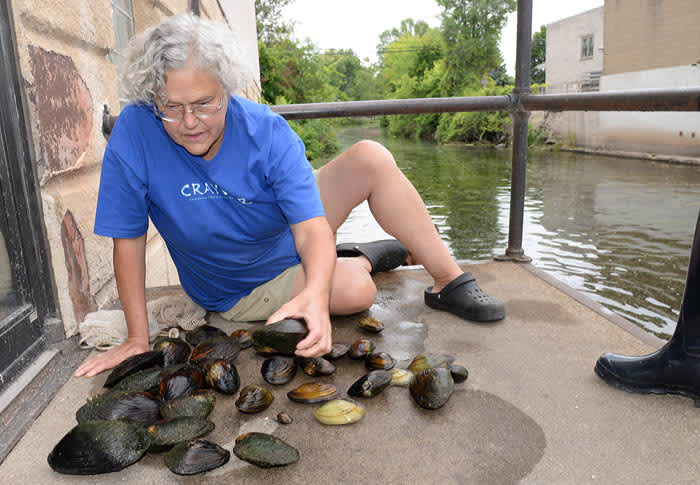Freshwater Mussels Deserve Some Love, Too
Patrick Durkin 09.11.14

Kind-hearted people who try to rescue or rehabilitate wildlife often get kicked, pecked, or bitten for their good intentions.
Don’t despair. If you want to help a native species that won’t hurt, juke, or otherwise humiliate you, consider giving some love to our country’s native freshwater mussels; or as most folks call them, “clams.”
Mussels won’t say thanks, but at least they won’t force you to play host to their young until the whelps can fend for themselves in a few weeks. No, mussels force that obligation onto fish, but more on that later.
Be assured, you don’t need special training to help mussels; at least not the ones you find stranded in sand or mud when water levels drop during droughts or reservoir drawdowns. Although mussels have a “foot” for burrowing or moving along a river or lake bottom, they don’t innately know the way to deeper water.

So, if you find a stranded mussel, heed this simple advice from Lisie Kitchel at the Wisconsin Department of Natural Resources (DNR): “Just pick them up and chuck them into deeper water.”
How’s that for heroics?
Don’t be skeptical. Kitchel is number-one in the Wisconsin DNR for all things mussel. She also says not to worry whether mussels land upside down after you toss them into the depths. They’ll use their foot to right themselves.
Of course, some mussels aren’t so easily rescued. In downtown Clintonville, Wisconsin, for example, the state Department of Transportation plans to rebuild the Main Street/Highway 22 bridge over the Pigeon River next spring. The riverbed below and downstream from the bridge holds about 15 species of mussels, including the “elktoe,” a species of “special concern.”
To save these mussels from possibly excessive debris, sediments, and other construction hazards, the DNR sent a diver and three snorkelers into the Pigeon River in late August to relocate them downriver. The team scoured about 30 yards of river-bottom from late morning to early afternoon, and gathered 680 mussels.
These mussels represented 14 species, of which the top three in abundance were the pink-heel splitter, the fragile paper-shell, and the fluted shell. Just don’t ask me to identify them. It takes expert eyes to recognize the subtleties of the mussels’ hinge designs, shell configurations, and color nuances.
Places like the Pigeon River remain relatively safe for native mussels. Their counterparts aren’t faring as well in larger river systems like the Mississippi, parts of the Wisconsin and St. Croix, and the nearby Winnebago System—all of which are under siege from invasive zebra mussels. Tiny zebra mussels colonize on the larger native mussels, often burying them beneath massive colonies.
These pests are just the latest threat to native mussels. For nearly 100 years Wisconsin’s mussels were exploited by manufacturers. From the 1880s through the early 1940s, button-makers cut clothes buttons from mussel shells, and soon after mussels from the Upper Mississippi River became Japan’s primary “seed” for culturing pearls in oysters.
All the while, mussel numbers dropped as widespread dam construction slowed river currents, thereby reducing the flow of nutrients that mussels filter for sustenance. Their numbers also plummeted as waterways became choked with pollutants from farm, human, and industrial wastes.

Wisconsin’s mussels rebounded in recent decades after the Clean Water Act of 1972, but even today half of the state’s 51 mussel species are endangered, threatened, or “of concern.”
All the while, they’re increasing in popularity as people learn more about them. As Kitchel notes, mussels can filter several gallons of water daily, removing pesticides, herbicides, heavy metals like mercury, and sediments that fuel algae blooms. But as a result, even if live mussels weren’t protected from harvest statewide, you wouldn’t want to risk eating them because they likely contain high loads of contaminants.
People are also fascinated by the mussels’ fishing tactics, which resemble our own. To reproduce, mussels must transfer their growing embryos, called glochidia, onto a fish’s eyes, gills, or other membranes. Glochidia basically staple themselves onto those soft tissues to extract blood for a few weeks before dropping off to live independently.
Rather than randomly spitting glochidia into the water and hoping for the best, female mussels go fishing. The Higgins’ eye mussel, for example, has a fleshy appendage that dances and wriggles like a minnow to attract bass and walleyes. When a fish moves in, the mussel blows glochidia into its face and mouth.
Another mussel, the snuffbox, uses a similar lure, but when a logperch—the one fish that can serve as host for this mussel—moves in, the snuffbox clamps onto the fish’s head and blasts glochidia into its face and mouth. Once purged, the mussel releases the fish.
Still other mussels emit sinewy nets or fish-attracting scents to attract unsuspecting hosts and transfer glochidia.
Given such sophisticated tricks, you might wonder if mussels really need our help. Rest assured, they do. To learn how you might help, consider participating in the Wisconsin DNR’s “Citizen Mussel Monitoring Project,” which can be found on the agency’s website.

